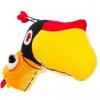Tin nhắn: 21
Nội dung: English
erinja (Xem thông tin cá nhân) 12:08:40 Ngày 28 tháng 4 năm 2013
sudanglo:Vakskreto is a nonsense. As you point out Chainy either it would be made of chalk or wax, I can't imagine a mixture is used. But maybe I am wrong.Vakskreto seems like nonsense to me as well. But I think it is referring to the form factor more than to the substance. A crayon is more similar in shape to a piece of chalk than to a pencil. This usage sounds weird and wrong to us as native English speakers, but I included it as an option because it has a firm basis in other European languages, and English is seldom used as a model for development of Esperanto vocabulary in any case.
Having said that, vakskrajono would be my personal choice, because I think it's easier to understand from a wider array of cultural backgrounds, and also because of the aforementioned word "globkrajono" (also a modification of the word 'pencil' with another root), which is well-known in the community.
Words like paŝtelo don't work for me. To me, that's an oil or chalk-based drawing implement, like the oil pastels or chalk pastels that we refer to in English, though maybe this is simply a false friend.
Rugxdoma (Xem thông tin cá nhân) 14:53:51 Ngày 28 tháng 4 năm 2013
erinja:Vakskreto seems like nonsense to me as well. But I think it is referring to the form factor more than to the substance.Even to me the word "vakskreto" seems bad, though the corresponding word in my mother tongue, Swedish, is created exactly the same way. (In fact, I found it illogical even when I as a child met the real "kretojn", when I started school - and even more so when I met "kreto" in the geography as well.)
I think this word illustrates the danger of applying Rule 15 generously. It is not enough that many European languages have a certain expression, or several big languages. The terms have to be logical too, both for international understandability and for durability over time.
That last thing, that expressions which were once understandable, cease to function after a while, perhaps is relevant to this thread in another way too. All the writing instruments so far discussed have been rather oldfashoned ones. To form a consistent terminology they perhaps should be included in the discussion.
Edited
Rugxdoma (Xem thông tin cá nhân) 15:12:01 Ngày 28 tháng 4 năm 2013
sudanglo (Xem thông tin cá nhân) 17:20:28 Ngày 28 tháng 4 năm 2013
Historically the way of putting together the words for vax and for chalk may have been highly justified. Ordinary people used chalk to draw and write and scribbleI think we would have to go back hundreds of years before the creation of Esperanto for a piece of chalk to be the usual writing instrument (classroom use excepted).
Rugxdoma (Xem thông tin cá nhân) 21:36:02 Ngày 29 tháng 4 năm 2013
sudanglo:That is how Rule 15 has been used: to pick up historically established illogical constructions, just because they appear in several languages.Historically the way of putting together the words for vax and for chalk may have been highly justified. Ordinary people used chalk to draw and write and scribbleI think we would have to go back hundreds of years before the creation of Esperanto for a piece of chalk to be the usual writing instrument (classroom use excepted).
Chainy (Xem thông tin cá nhân) 13:13:25 Ngày 01 tháng 5 năm 2013
crayon = (wax) vakskrajono
------
The following are already in the Lernu dictionary:
1. pencil = krajono
2. pastel = paŝtelo
3. ballpoint pen = globkrajono, globskribilo
------
Maybe it's also worth adding 'vaksmarkilo' (= grease pencil, wax pencil, china marker, chinagraph pencil). Not too sure about this one, though...
------
Rather bizarrely, there was no entry for 'chalk' in the Lernu dictionary, but I've now created one.
jaidit (Xem thông tin cá nhân) 22:08:39 Ngày 01 tháng 5 năm 2013
Chainy:Crayons seem to be more related to pastels (vakspaŝteloj) than to graphite pencils (there are pencils of other sorts which probably better merit the term krajono).pdenisowski:The Wells dictionary gives these translations:
ESPDIC has the following :
kolorilo : crayon, paint, dye [pretty generic]
paŝtelo : crayon, pastel [more specific]
CEED and Fulcher and Long both have paŝtelo, with the CEED adding a note ("not krajono!" ) and F&L giving "chalk" as a meaning as well.
crayon = paŝtelo
pastel = paŝtel-o, -a
But I'm not so sure that a crayon is the same thing as a pastel!
Regarding the note "not krajono", I wonder what Fulcher and Long would have said about 'vakskrajono'?
pdenisowski:By analogy to French "crayon de couleur" or Spanish "lápiz de color" you could use something like "kolorkrajono" although in my mind this is more of a colored pencil than a crayon.yes, 'kolorkrajono' must surely mean 'coloured pencil'.
I suppose it all gets a bit confusing as it's very tempting to use '-krajono' in a similar way to '-stift' in German (a writing, painting, drawing pen/pencil etc), but this is not officially correct and so it's done in an incomplete way. A good example of the muddle is 'globkrajono' (ballpoint pen).
Chainy (Xem thông tin cá nhân) 23:18:47 Ngày 01 tháng 5 năm 2013
jaidit:Crayons seem to be more related to pastels (vakspaŝteloj) than to graphite pencils (there are pencils of other sorts which probably better merit the term krajono).I suppose there's a lot of overlap between these things. Depends on the type of crayon etc...
The Collins dictionary actually uses the word 'crayon' in its definition of a pastel:
Pastel = 1. a substance made of ground pigment bound with gum, used for making sticks for drawingAnd then ReVo and Vortaro.net both use 'krajono' in their definition of 'paŝtelo':
2. a crayon of this
3. a drawing done in such crayons
paŝtelo = Krajono farita el pulvorigita kolorilo kaj gumo.The Collins dictionary also uses 'pencil' in its definition of 'crayon':
crayon = a small stick or pencil of charcoal, wax, clay, or chalk mixed with coloured pigment.It all goes round in circles!
Chainy (Xem thông tin cá nhân) 00:08:00 Ngày 02 tháng 5 năm 2013
A wax pastel is some kind of pigment with wax as the binding agent, and you can say the same for a 'crayon'. The difference is just in the quality and proportion of those ingredients - I suppose this is why the Wells dictionary chose 'paŝtelo' as the translation for both 'crayon' and 'pastel'.
I suppose 'vakskrajono' might still be a good translation for certain types of 'crayon/pastel' (some are more pencil-like in form). To be honest, I'm not too sure anymore. Shall we just put a few options in for users to decide for themselves, depending on the exact implement that they are refering to?
How about:
crayon = (vaks)paŝtelo, vakskrajono.
Of course, it could also be (kret-/braĝ-)paŝtelo/krajono!
Bemused (Xem thông tin cá nhân) 11:45:10 Ngày 02 tháng 5 năm 2013
Uses existing Esperanto roots and clearly distinguishes from other types of writing instruments such as pencils and chalk.



